4.1.9: Identify Accurate Drawings of Triangles
- Page ID
- 14873
\( \newcommand{\vecs}[1]{\overset { \scriptstyle \rightharpoonup} {\mathbf{#1}} } \)
\( \newcommand{\vecd}[1]{\overset{-\!-\!\rightharpoonup}{\vphantom{a}\smash {#1}}} \)
\( \newcommand{\id}{\mathrm{id}}\) \( \newcommand{\Span}{\mathrm{span}}\)
( \newcommand{\kernel}{\mathrm{null}\,}\) \( \newcommand{\range}{\mathrm{range}\,}\)
\( \newcommand{\RealPart}{\mathrm{Re}}\) \( \newcommand{\ImaginaryPart}{\mathrm{Im}}\)
\( \newcommand{\Argument}{\mathrm{Arg}}\) \( \newcommand{\norm}[1]{\| #1 \|}\)
\( \newcommand{\inner}[2]{\langle #1, #2 \rangle}\)
\( \newcommand{\Span}{\mathrm{span}}\)
\( \newcommand{\id}{\mathrm{id}}\)
\( \newcommand{\Span}{\mathrm{span}}\)
\( \newcommand{\kernel}{\mathrm{null}\,}\)
\( \newcommand{\range}{\mathrm{range}\,}\)
\( \newcommand{\RealPart}{\mathrm{Re}}\)
\( \newcommand{\ImaginaryPart}{\mathrm{Im}}\)
\( \newcommand{\Argument}{\mathrm{Arg}}\)
\( \newcommand{\norm}[1]{\| #1 \|}\)
\( \newcommand{\inner}[2]{\langle #1, #2 \rangle}\)
\( \newcommand{\Span}{\mathrm{span}}\) \( \newcommand{\AA}{\unicode[.8,0]{x212B}}\)
\( \newcommand{\vectorA}[1]{\vec{#1}} % arrow\)
\( \newcommand{\vectorAt}[1]{\vec{\text{#1}}} % arrow\)
\( \newcommand{\vectorB}[1]{\overset { \scriptstyle \rightharpoonup} {\mathbf{#1}} } \)
\( \newcommand{\vectorC}[1]{\textbf{#1}} \)
\( \newcommand{\vectorD}[1]{\overrightarrow{#1}} \)
\( \newcommand{\vectorDt}[1]{\overrightarrow{\text{#1}}} \)
\( \newcommand{\vectE}[1]{\overset{-\!-\!\rightharpoonup}{\vphantom{a}\smash{\mathbf {#1}}}} \)
\( \newcommand{\vecs}[1]{\overset { \scriptstyle \rightharpoonup} {\mathbf{#1}} } \)
\( \newcommand{\vecd}[1]{\overset{-\!-\!\rightharpoonup}{\vphantom{a}\smash {#1}}} \)
\(\newcommand{\avec}{\mathbf a}\) \(\newcommand{\bvec}{\mathbf b}\) \(\newcommand{\cvec}{\mathbf c}\) \(\newcommand{\dvec}{\mathbf d}\) \(\newcommand{\dtil}{\widetilde{\mathbf d}}\) \(\newcommand{\evec}{\mathbf e}\) \(\newcommand{\fvec}{\mathbf f}\) \(\newcommand{\nvec}{\mathbf n}\) \(\newcommand{\pvec}{\mathbf p}\) \(\newcommand{\qvec}{\mathbf q}\) \(\newcommand{\svec}{\mathbf s}\) \(\newcommand{\tvec}{\mathbf t}\) \(\newcommand{\uvec}{\mathbf u}\) \(\newcommand{\vvec}{\mathbf v}\) \(\newcommand{\wvec}{\mathbf w}\) \(\newcommand{\xvec}{\mathbf x}\) \(\newcommand{\yvec}{\mathbf y}\) \(\newcommand{\zvec}{\mathbf z}\) \(\newcommand{\rvec}{\mathbf r}\) \(\newcommand{\mvec}{\mathbf m}\) \(\newcommand{\zerovec}{\mathbf 0}\) \(\newcommand{\onevec}{\mathbf 1}\) \(\newcommand{\real}{\mathbb R}\) \(\newcommand{\twovec}[2]{\left[\begin{array}{r}#1 \\ #2 \end{array}\right]}\) \(\newcommand{\ctwovec}[2]{\left[\begin{array}{c}#1 \\ #2 \end{array}\right]}\) \(\newcommand{\threevec}[3]{\left[\begin{array}{r}#1 \\ #2 \\ #3 \end{array}\right]}\) \(\newcommand{\cthreevec}[3]{\left[\begin{array}{c}#1 \\ #2 \\ #3 \end{array}\right]}\) \(\newcommand{\fourvec}[4]{\left[\begin{array}{r}#1 \\ #2 \\ #3 \\ #4 \end{array}\right]}\) \(\newcommand{\cfourvec}[4]{\left[\begin{array}{c}#1 \\ #2 \\ #3 \\ #4 \end{array}\right]}\) \(\newcommand{\fivevec}[5]{\left[\begin{array}{r}#1 \\ #2 \\ #3 \\ #4 \\ #5 \\ \end{array}\right]}\) \(\newcommand{\cfivevec}[5]{\left[\begin{array}{c}#1 \\ #2 \\ #3 \\ #4 \\ #5 \\ \end{array}\right]}\) \(\newcommand{\mattwo}[4]{\left[\begin{array}{rr}#1 \amp #2 \\ #3 \amp #4 \\ \end{array}\right]}\) \(\newcommand{\laspan}[1]{\text{Span}\{#1\}}\) \(\newcommand{\bcal}{\cal B}\) \(\newcommand{\ccal}{\cal C}\) \(\newcommand{\scal}{\cal S}\) \(\newcommand{\wcal}{\cal W}\) \(\newcommand{\ecal}{\cal E}\) \(\newcommand{\coords}[2]{\left\{#1\right\}_{#2}}\) \(\newcommand{\gray}[1]{\color{gray}{#1}}\) \(\newcommand{\lgray}[1]{\color{lightgray}{#1}}\) \(\newcommand{\rank}{\operatorname{rank}}\) \(\newcommand{\row}{\text{Row}}\) \(\newcommand{\col}{\text{Col}}\) \(\renewcommand{\row}{\text{Row}}\) \(\newcommand{\nul}{\text{Nul}}\) \(\newcommand{\var}{\text{Var}}\) \(\newcommand{\corr}{\text{corr}}\) \(\newcommand{\len}[1]{\left|#1\right|}\) \(\newcommand{\bbar}{\overline{\bvec}}\) \(\newcommand{\bhat}{\widehat{\bvec}}\) \(\newcommand{\bperp}{\bvec^\perp}\) \(\newcommand{\xhat}{\widehat{\xvec}}\) \(\newcommand{\vhat}{\widehat{\vvec}}\) \(\newcommand{\uhat}{\widehat{\uvec}}\) \(\newcommand{\what}{\widehat{\wvec}}\) \(\newcommand{\Sighat}{\widehat{\Sigma}}\) \(\newcommand{\lt}{<}\) \(\newcommand{\gt}{>}\) \(\newcommand{\amp}{&}\) \(\definecolor{fillinmathshade}{gray}{0.9}\)Whether a triangle is correct based on law of cosines.
Your friend is creating a new board game that involves several different triangle shaped pieces. However, the game requires accurate measurements of several different pieces that all have to fit together. She brings some of the pieces to you and asks if you can verify that her measurements of the pieces' side lengths and angles are correct.
You take out the first piece. According to your friend, the piece has sides of length 4 in, 5 in and 7 in, and the angle between the side of the length 4 and the side of length 5 is \(78^{\circ} \). She's very confident in the lengths of the sides, but not quite sure if she measured the angle correctly. Is there a way to determine if your friend's game piece has the correct measurements, or did she make a mistake?
Analyzing Triangles
Our extension of the analysis of triangles draws us naturally to oblique triangles.
The Law of Cosines can be used to verify that drawings of oblique triangles are accurate. In a right triangle, we might use the Pythagorean Theorem to verify that all three sides are the correct length, or we might use trigonometric ratios to verify an angle measurement. However, when dealing with an obtuse or acute triangle, we must rely on the Law of Cosines.
For the following problems, let's use the Law of Cosines
1. In \(\Delta ABC\) at the right, \(a=32\), \(b=20\), And \(c=16\). Is the drawing accurate if it labels \(\angle C\) as \(35.2^{\circ} \)? If not, what should \(\angle C\) measure?
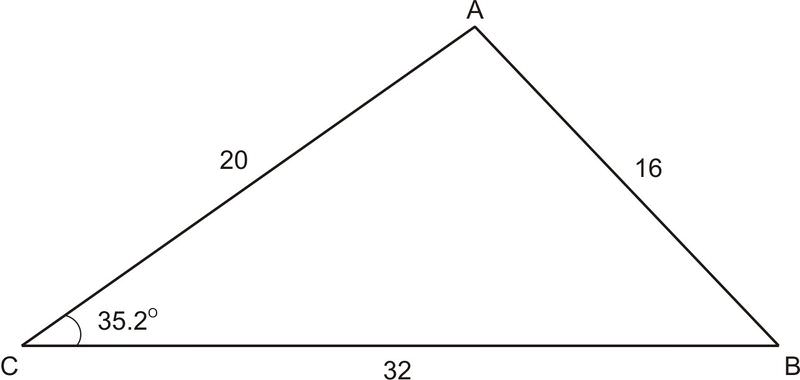
We will use the Law of Cosines to check whether or not \(\angle C\) is \(35.2^{\circ} \).
\(\begin{aligned}
16^{2}&=20^{2}+32^{2}-2(20)(32) \cos 35.2 && \text { Law of Cosines }\\
256&=400+1024-2(20)(32) \cos 35.2 && \text { Simply squares }\\
256&=400+1024-1045.94547 && \text { Multiply }\\
256 &\neq 378.05453 && \text { Add and subtract }
\end{aligned}\)
Since \(256\neq 378.05453\), we know that \(\angle C\) is not \(35.2^{\circ} \). Using the Law of Cosines, we can figure out the correct measurement of \(\angle C\).
\(\begin{aligned}
16^{2}&=20^{2}+32^{2}-2(20)(32) \cos C && \text { Law of Cosines }\\
256&=400+1024-2(20)(32) \cos C && \text { Simplify Squares } \\
256&=400+1024-1280 \cos C && \text { Multiply } \\
256&=1424-1280 \cos C && \text { Add }\\
-1168&=-1280 \cos C && \text { Subtract } \\
0.9125&=\cos C && \text { Divide }
\\
24.1^{\circ} &\approx \angle C && \cos^{−1} (0.9125)
\end{aligned}\)
For some situations, it will be necessary to utilize not only the Law of Cosines, but also the Pythagorean Theorem and trigonometric ratios to verify that a triangle or quadrilateral has been drawn accurately.
2. A builder received plans for the construction of a second-story addition on a house. The diagram shows how the architect wants the roof framed, while the length of the house is 20 ft. The builder decides to add a perpendicular support beam from the peak of the roof to the base. He estimates that new beam should be 8.3 feet high, but he wants to double-check before he begins construction. Is the builder’s estimate of 8.3 feet for the new beam correct? If not, how far off is he?
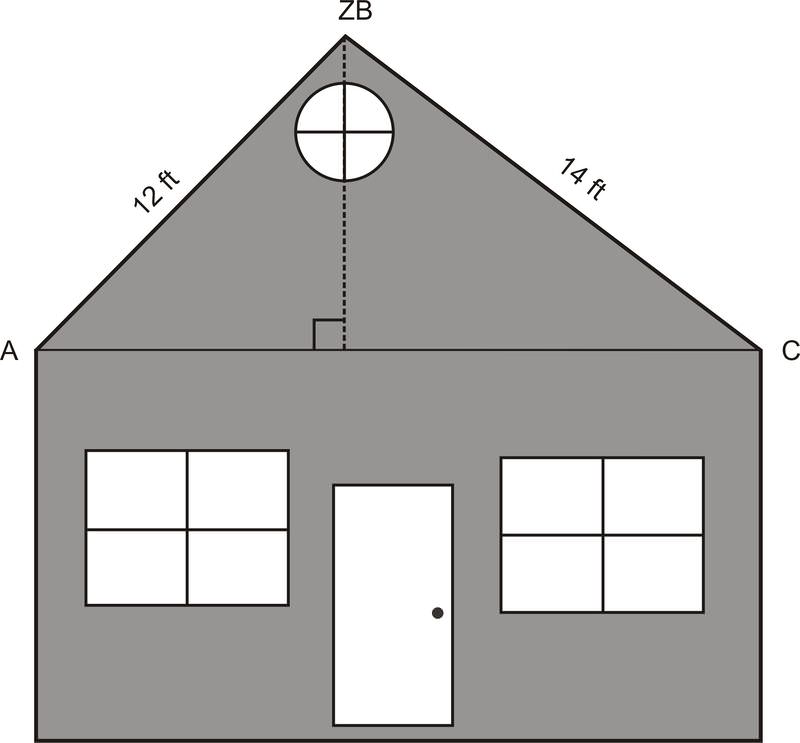
If we knew either \(\angle A\) or \(\angle C\), we could use trigonometric ratios to find the height of the support beam. However, neither of these angle measures are given to us. Since we know all three sides of \(\Delta ABC\), we can use the Law of Cosines to find one of these angles. We will find \(\angle A\).
\(\begin{aligned} 14^2 &=12^2+20^2−2(12)(20)\cos A && \text{Law of Cosines}\\ 196&=144+400−480\cos A &&\text{Simplify}\\ 196& =544−480\cos A && \text{Add}\\ −348&=−480\cos A && \text{Subtract}\\ 0.725&=\cos A &&\text{Divide}\\ 43.5^{\circ}&\approx \angle A && \cos ^{−1}(0.725)\end{aligned}\)
Now that we know \(\angle A\), we can use it to find the length of \(BD\).
\(\begin{aligned} \sin 43.5 &=\dfrac{x}{12}\\ 12 \sin43.5 &=x\\ 8.3&\approx x\end{aligned}\)
Yes, the builder’s estimate of 8.3 feet for the support beam is accurate.
In \(\Delta CIR\), \(c=63\), \(i=52\), and \(r=41.9\). Find the measure of all three angles.
\(\begin{aligned} 63^2&=52^2+41.9^2−2\cdot 52\cdot 41.9\cdot \cos C \\ 52^2&=63^2+41.9^2−2\cdot 63\cdot 41.9\cdot \cos I \\ 180^{\circ} −83.5^{\circ} −55.1^{\circ} &=41.4^{\circ} \\ \angle C &\approx 83.5^{\circ} \\ \angle I&\approx 55.1^{\circ} \\ \angle R&\approx 41.4^{\circ} \end{aligned}\)
Earlier, you were asked if there was a way to determine if your friend's game piece has the correct measurements.
Solution
Since your friend is certain of the lengths of the sides of the triangle, you should use those as the known quantities in the Law of Cosines and solve for the angle:
\(\begin{aligned} 7^2&=5^2+4^2+(2)(5)(4)\cos \theta \\ 49&=25+16+40\cos \theta \\ 49−25−16&=40\cos \theta \\ \dfrac{8}{40}&=\cos \theta \\ \cos ^{−1}\dfrac{8}{40}&=\theta \\ \theta &=78.46 \end{aligned}\)
So as it turns out, your friend is rather close. Her measurements were probably slight inaccurate because of her round off from the protractor.
Find \(AD\) using the Pythagorean Theorem, Law of Cosines, trig functions, or any combination of the three.
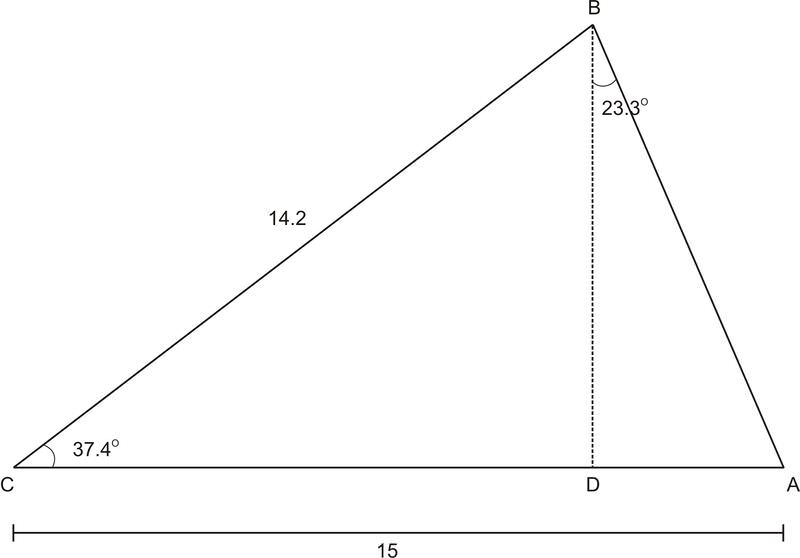
Solution
First, find \(AB\).
\(AB^2=14.2^2+15^2−2\cdot 14.2\cdot 15\cdot \cos 37.4^{\circ} \), \(AB=9.4\). \(\sin 23.3^{\circ} =\dfrac{AD}{9.4}\), \(AD=3.7\).
Find \(HK\) using the Pythagorean Theorem, Law of Cosines, trig functions, or any combination of the three if \(JK=3.6\), \(KI=5.2\), \(JI=1.9\), \(HI=6.7\), and \(\angle KJI=96.3^{\circ} \).
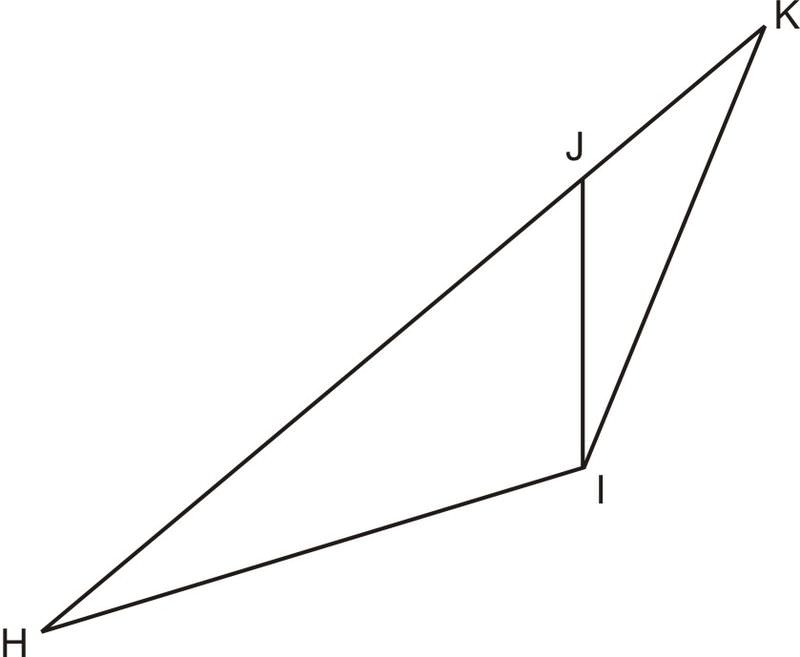
Solution
\(\angle HJI=180^{\circ} −96.3^{\circ} =83.7^{\circ} \) (these two angles are a linear pair). \(6.7^2=HJ^2+1.9^2−2\cdot HJ\cdot 1.9\cdot \cos 83.7^{\circ} \). This simplifies to the quadratic equation \(HJ^2−0.417HJ−41.28\). Using the quadratic formula, we can determine that \(HJ\approx 6.64\). So, since \(HJ+JK=HK\), \(6.64+3.6\approx HK\approx 10.24\).
Use the Law of Cosines to determine whether or not the following triangle is drawn accurately. If not, determine how far the measurement of side "\(d\)" is from the correct value.

Solution
To determine this, use the Law of Cosines and solve for d to determine if the picture is accurate. \(d^2=12^2+24^2−2\cdot 12\cdot 24\cdot \cos 30^{\circ} \), \(d=14.9\), which means \(d\) in the picture is off by 1.9.
Review
- If you know the lengths of all three sides of a triangle and the measure of one angle, how can you determine if the triangle is drawn accurately?
Determine whether or not each triangle is labelled correctly.
-
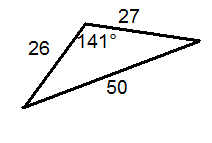
Figure \(\PageIndex{6}\) -

Figure \(\PageIndex{7}\) -
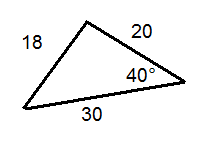
Figure \(\PageIndex{8}\) -
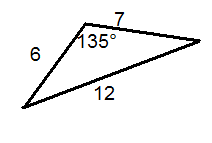
Figure \(\PageIndex{9}\) -
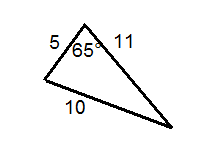
Figure \(\PageIndex{10}\) -

Figure \(\PageIndex{11}\)
Determine whether or not each described triangle is possible. Assume angles have been rounded to the nearest degree.
- In \(\Delta BCD\), \(b=4\), \(c=4\), \(d=5\), and \(m\angle B=51^{\circ} \).
- In \(\Delta ABC\), \(a=7\), \(b=4\), \(c=9\), and \(m\angle B=34^{\circ} \).
- In \(\Delta BCD\), \(b=3\), \(c=2\), \(d=7\), and \(m\angle D=138^{\circ} \).
- In \(\Delta ABC\), \(a=8\), \(b=6\), \(c=13.97\), and \(m\angle C=172^{\circ} \).
- In \(\Delta ABC\), \(a=4\), \(b=4\), \(c=9\), and \(m\angle B=170^{\circ} \).
- In \(\Delta BCD\), \(b=3\), \(c=5\), \(d=4\), and \(m\angle C=90^{\circ} \).
- In \(\Delta ABC\), \(a=8\), \(b=3\), \(c=6\), and \(m\angle A=122^{\circ} \).
- If you use the Law of Cosines to solve for \(m\angle C\) in \(\Delta ABC\) where \(a=3\), \(b=7\), and \(c=12\), you will an error. Explain why.
Review (Answers)
To see the Review answers, open this PDF file and look for section 5.3.
Vocabulary
| Term | Definition |
|---|---|
| law of cosines | The law of cosines is a rule relating the sides of a triangle to the cosine of one of its angles. The law of cosines states that \(c^2=a^2+b^2−2ab\cos C\), where \(C\) is the angle across from side \(c\). |

